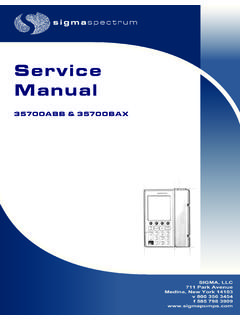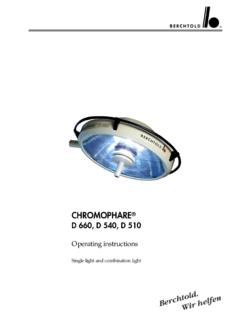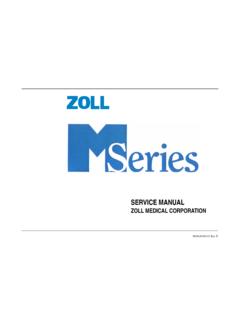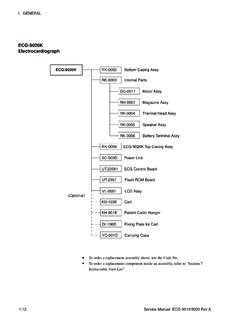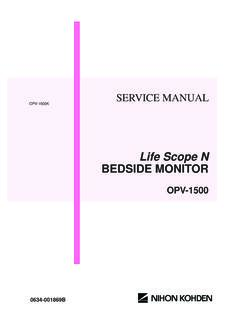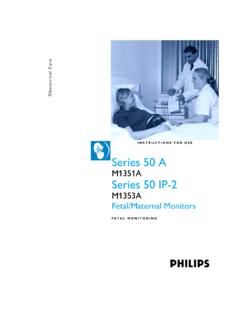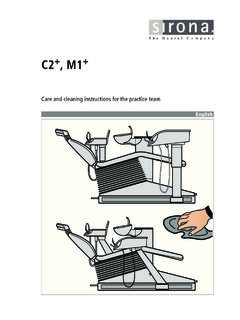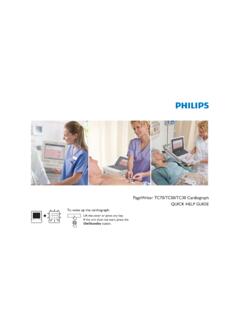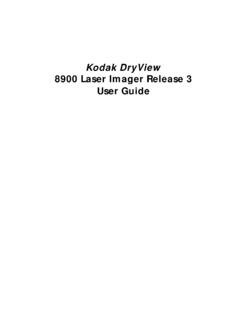Transcription of Automated Blood Coagulation Analyzer CA-500
1 INSTRUCTIONS FOR USE. Automated Blood Coagulation Analyzer CA-500 series CHAPTER 1: Introduction CHAPTER 2: Safety Information CHAPTER 3: Design and Function CHAPTER 4: Installation Environment CHAPTER 5: Operation CHAPTER 6: Display and Processing of Analysis Results CHAPTER 7: Output CHAPTER 8: Quality Control CHAPTER 9: Setting Standard Curve CHAPTER 10: Instrument Setup CHAPTER 11: Maintenance and Supplies Replacement CHAPTER 12: Troubleshooting CHAPTER 13: Functional Description CHAPTER 14: Technical Information CHAPTER 15: Index CHAPTER 16: Appendix (A). SYSMEX CORPORATION. KOBE, JAPAN. Copyright 2001-2004 by SYSMEX CORPORATION. All rights reserved. No part of this Instruction for Use may be Code No. 461-2655-0. reproduced in any form or by any means whatsoever without PRINTED IN JAPAN. prior written permission of SYSMEX CORPORATION. Date of Last Revision: April 2004.
2 Software version 00-17 and onwards Table of Contents 1. Introduction .. 1-1. Introduction .. 1-1. Explanation of Signs .. 1-3. Names .. 1-4. Serial 1-4. Revision History .. 1-4. 2. Safety Information .. 2-1. Specified Conditions of Use .. 2-1. General Information .. 2-1. Installation Location .. 2-3. Avoidance of Infections .. 2-3. Handling of Reagents .. 2-4. Maintenance of the Instrument .. 2-5. Disposal of Materials .. 2-5. Markings on the Instrument .. 2-6. Personnel .. 2-8. Storage Condition (Transportation) .. 2-8. 3. Design and Function .. 3-1. Overview .. 3-1. Operation Flow .. 3-8. 4. Installation Environment .. 4-1. Installation and Relocation .. 4-1. Installation Location .. 4-1. Basic Instrument Settings .. 4-3. Revised November 2003 - Sysmex CA-500 series I. 5. Operation ..5-1. Display Screens and Operation Keys .. 5-1. Menu Tree .. 5-3.
3 Types of Alarm .. 5-5. Inspection before Turning ON the Power .. 5-5. Turn ON the Power .. 5-7. Prepare Reagents .. 5-8. Set Reaction Tubes .. 5-13. Confirm Standard Curve .. 5-14. Execute Quality Control .. 5-15. Prepare Samples .. 5-15. Set Sample Nos.. 5-19. Manual Inquiry .. 5-22. Automatic Inquiry .. 5-22. Start Analysis .. 5-24. Automatic Sensitivity Adjustment of the Detector (for CA-530, CA-540, CA-550 and CA-560 only) .. 5-26. Display Analysis Result .. 5-27. Interrupt Analysis .. 5-28. Add Samples .. 5-29. Analyze STAT Sample .. 5-30. Emergency Stop .. 5-31. Shutdown .. 5-33. 6. Display and Processing of Analysis Results ..6-1. List Display/Graphic Display .. 6-1. Search .. 6-6. Sort in Sequence of Sample ID Nos. and Analyses .. 6-9. Select Display .. 6-9. Edit ID No.. 6-11. Deletion .. 6-12. 7. Output ..7-1. Automatic Printout of Analysis Data.
4 7-1. Output of Analysis Data .. 7-1. Example of Printout .. 7-3. 8. Quality Control ..8-1. Quality Control Methods .. 8-1. QC File Setting .. 8-1. Execute Quality Control .. 8-5. Revised January 2003 - Display QC Charts .. 8-5. Delete QC File .. 8-7. Delete QC Data .. 8-8. Print QC data .. 8-9. II Sysmex CA-500 series 9. Setting Standard Curve .. 9-1. Display Standard Curve .. 9-1. Standard Curve Analysis .. 9-3. INR Manual Dilution Analysis .. 9-6. Manual Entry .. 9-8. Set Reagent Information .. 9-9. Set Calculation Parameters .. 9-10. Print Standard Curve .. 9-13. 10. Instrument Setup .. 10-1. General Information .. 10-1. Setup of Automatic Transfer/Printout .. 10-2. Judgment on Analysis Result .. 10-4. Replication Range .. 10-6. Report Limit .. 10-7. Setup of Test Name .. 10-8. Reagent Name .. 10-9. Test Protocol .. 10-10. Replication .. 10-19.
5 Setup of Test Group .. 10-20. Reagent Holder .. 10-21. Setup of Reagent Volume Monitoring .. 10-23. Setting of Conversion Formula .. 10-23. Devices to be Connected .. 10-24. Setup of System .. 10-26. Password Settings .. 10-28. Printout of Settings .. 10-29. Addition of New Analysis Parameters .. 10-30. Reagent Name/Holder List .. 10-31. Revised January 2003 - Sysmex CA-500 series III. 11. Maintenance and Supplies Replacement ..11-1. Maintenance Schedule .. 11-1. Clean Sample Probe .. 11-2. Discard Used Reaction Tubes .. 11-3. Dispose of Waste .. 11-4. Remove Dew from Reagent Rack (for CA-530, CA-540, CA-550 and CA-560 only) .. 11-5. LED Calibration .. 11-6. Replace Rinse Filter .. 11-9. Supply Printer Paper .. 11-9. Replace Fuse .. 11-11. Check and Drain Trap Chamber .. 11-11. Prime Rinse Solution to Hydraulic Line .. 11-12. Clean Instrument .. 11-13.
6 Replenish Reagent .. 11-14. Replenish Reaction Tubes .. 11-16. Replenish Rinse Solution .. 11-18. Supply Parts List .. 11-19. 12. Troubleshooting ..12-1. Introduction .. 12-1. Error Corrective Procedure .. 12-2. Analysis Data Error .. 12-13. Cycle Counter .. 12-14. Sysmex Menu .. 12-15. Special Operation .. 12-16. 13. Functional Description ..13-1. Detection Principle of Coagulation Method (PT, APTT, Fbg, TT, PCcl, BXT, LA1*, LA2*, Factor Deficiency) .. 13-1. Detection Principle of Chromogenic Method (AT3, APL*, Plg*, PC, Hep: CA-530, CA-540, CA-550 and CA-560 only) .. 13-4. Detection Principle of Immunology Method (D-Dimer, P-FDP*: CA-550 and CA-560 only) .. 13-5. Analysis Mechanism .. 13-7. Analysis Flow .. 13-7. Reference Procedures .. 13-16. 14. Technical Information ..14-1. Instrument Specifications .. 14-1. Installation .. 14-8. Serial Interface for Host Computer.
7 14-17. Text Format .. 14-24. Revised January 2003 - ID Barcode .. 14-34. 15. Index ..15-1. 16. Appendix (A) ..16-1. Maintenance CheckList .. 16-1. Reagents .. 16-3. IV Sysmex CA-500 series 1. Introduction ..1-1. Introduction ..1-1. Explanation of Signs ..1-3. Names ..1-4. Serial Number ..1-4. Revision History ..1-4. Revised January 2003 - Sysmex CA-500 series Introduction 1. Introduction Introduction The Sysmex Automated Blood Coagulation Analyzer CA-500 series is a compact fully- Automated instrument capable of 5-parameter random analysis for In Vitro Diagnostic use. This instrument incorporates latest technologies as represented by micro- computers, thus enabling analysis of multiple parameters with increased flexibility. Of PT, APTT, Fbg, Thrombin Time ( Coagulation Method), and Antithrombin III (Chromogenic Method: Can be analyzed only with CA-530, CA-540, CA-550 and CA-560), D-Dimer (Immunology Method: Can be analyzed only with CA-550 and CA-560), etc.
8 , this instrument is able to analyze 5 parameters simultaneously. In addition, it has a number of functions including preferential processing of STAT. samples and a built-in quality control function. Moreover, it allows analyzed data to be displayed and printed out together with reaction curves, thus making it possible to obtain highly reliable analysis results. Analysis Parameters and Detection Principles Parameter Test name Applied Prothrombin Time PT Coagulation Method Activated Partial Thromboplastin Time APTT Coagulation Method Fibrinogen Fbg Coagulation Method Thrombin Time TT Coagulation Method Protein C coagulometric PCcl Coagulation Method Batroxobin BXT Coagulation Method LA1 Screening* LA1 Coagulation Method LA2 Confirmation* LA2 Coagulation Method Factor Assay** II, V, VII, VIII, IX, Coagulation Method X, XI, XII. Antithrombin III AT3 Chromogenic Method 2-Antiplasmin* APL Chromogenic Method Plasminogen* Plg Chromogenic Method Protein C chromogenic BCPC Chromogenic Method Heparin Hep Chromogenic Method D-Dimer Plus*, Advanced D-Dimer** DDPl, AdDD Immunoassay Method Revised January 2003 - P-FDP** PFDP Immunoassay Method (*) Not available in the USA.
9 (**) Data evaluated for factors VII and VIII only. (**) Only available for use in the USA. (**) Only available for use in Asia. Sysmex CA-500 series 1-1. Introduction Manufacturer SYSMEX CORPORATION. 1-5-1 Wakinohama-Kaigandori Chuo-ku, Kobe 651-0073. Japan European Representative SYSMEX EUROPE GmbH. Bornbarch 1. D 22848 Norderstedt Tel.: +49 40 5 27 26-0. Fax: Tel.: +49 40 5 27 26-100. Ordering of Supplies and Replacement Parts If you need to order supplies or replacement parts, please contact your local Sysmex representative. Service and Maintenance Please contact the Service Department of your local Sysmex representa- tive. Training Courses For further information please contact the Sysmex representative in your country. CE-Mark The IVD system described in this manual is marked with a CE mark which confirms the observance of the essential requirements of the fol- lowing European directives: -98/79/EC in-Vitro Diagnostics Directive.
10 CA-500 series instruments with serial numbers shown below or smaller numbers only conform to the 89/336/EEC electromagnetic compatibility. Revised January 2003 - CA-510 A1342. CA-520 A1017. CA-530 A1902. CA-540 A3883. CA-550 A1051. CA-560 A1110. 1-2 Sysmex CA-500 series Introduction Explanation of Signs This manual carries a variety of illustrations to make sure that the prod- uct can be used safely and correctly, thus preventing users and others from suffering injuries and damage to property. The illustrations and meaning are described in the following. Do understand what they mean before proceeding to the text of the MANUAL. Risk of Infection Indicates the presence of a biohazardous material or condition. Warning If this sign is ignored and the instrument is operated incorrectly, there is a potentially hazardous situation which could result in death or serious injury of operator, or grave property damage.
